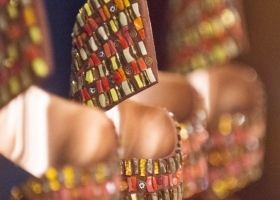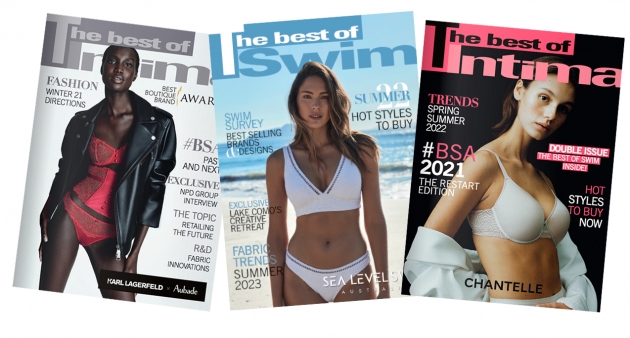
The Best ofIntima & Swim Edit
Best Foot Forward: Opportunities in a Waste-Averse & Ethically Aware Marketplace
08 August 2019
In this issue of The Best of Intima, we have invited London-based design and trend consultant Catherine van Baal to present her take on market changes as our guest expert.

In her insightful article, she presents some new strategy adaptations to present a balanced product mix that offers newness in a market where sustainability and inclusivity are key.
Resale is being reported as a
booming market where savvy
fashionistas make product
decisions with entrepreneurial sensibility. It is
also a huge focus for influencers on Instagram
who are driving the movement. How can we
look at key resale pieces for intimate garments?
It is slightly more complex than it may appear
at first glance. Naturally, panty garments are
less likely to achieve a high level of resale
response, but let’s not forget the other key
product areas included within intimates.
Luxury loungewear has seen impressive
growth in recent years, where premium quality
yarns are used with high level finishing.
Customers who have a garment lifecycle preloved
mindset are more likely to make a quality
purchase that has the potential for resale. In
particular, high quality worn-to-be-seen items
have the potential to become heirlooms and
have an advantage as they appeal to a wider
resale audience. When looking for inspiration, it
is worth taking a look at at festival and party
contour garments- items that underpin novelty
resale- where there are some key opportunities
to be found: often embellishments, complex
cutting and hand drawn prints created in small
runs can inspire the conscious-minded
customer to make their all important purchase.
When it comes to the shift towards resale, the
generational divide between the youth and
older people doesn’t appear to have an impact.
Where the younger generation is predominantly
looking for ways of making more conscious
choices, the older generation seeks timeless,
well-crafted perennial items with both of these
thought processes aligning to enhance resale
activity across the board.

THE DETOX
JOURNEY
Key online second hand or
repurposing sites offer what
they call a fashion detox
journey, where experts
manage the entire process
and make it easy to shift
unwanted garments.
Thredup in particular
supports the whole resale
process and claims to make
it a seamless journey. In Fall
2018, they launched a
collaborative service with
mission-based fashion brand
Reformation to offer a
circular service:
Reformation x Thredup.
This new service enabled
you to turn your old clothes
into new Reformation
shopping credit.
Online resale platform
Depop focuses on speed:
users can snap a pic on their
phone & upload it for
instant interaction. Faster models use
clever tagging and slick navigation to aid
the resale journey and aim to deliver
speedily on their promises. This faster
process, much like its content, is targeted
at the mid to lower-end in terms of price
point, whereas The Vestiaire Collective
pitch themselves at the luxury market
where the value of garments sold is
considerably higher and from sought after
fashion houses. Items sold are physically
verified and authenticated by a team of
experts, giving a look and feel that is more
in line with its contents and users and in
April 2019 the new CEO Max Bittner made
substantial changes to its commission
structure in order to enhance performance
and competitive resale opportunities.
As more and more secondhand clothing
outlets add sleek, curated web platforms,
this allows consumers much wider choice
than simply buying virgin garments. With
64% of people now willing to buy pre
loved, it seems we are officially entering
the golden age of secondhand shopping.

PULLING FROM THE
NEW RHYTHM
Alongside resale, rental markets have been forecast
to beat fast fashion sales by 2020 – it is time for
brands to stand up for sustainability; they must act
now or risk their future. This game is moving fast and
the brands leading the field are the direct-toconsumer
businesses who are digital natives and have
been built with sustainability in mind. The end game
is of course to limit landfill; brands should see resale
and rental as an opportunity not a threat.
So how do brands and retailers pull from this new
rhythm? There is a wider opportunity for retailers and
brands to improve their green credentials by adopting
the re-use mindset and wrapping it into product
development. Alongside this, gentle marketing
strategies can nod to the trend by adding widerreaching
thought to the hero piece in a collection. It is
all about mapping a products journey, improving
longevity and enhancing end use by creating products
that will hold their value as a quality item, thus being
more sustainable. Transparency is key: for consumers,
knowing where and how a garment has been created
has become increasingly important.
Always a hit on Instagram are hero pieces that
promise to hold their value as a quality and
sustainable item with the potential for extended end
use. When it comes to creating a collection hero
piece, brands must be aware that there are additional
pointers to nod to outside of the sustainable storyline:
it is important to have an inclusive view point, to offer
the perfect fit and to use sourcing strategies to
underpin shared goals and beliefs. For the larger
retailer or global brand, this may mean revisiting best
sellers and upscaling them with enhancements that
can be underlined using innovative marketing.
Look out for Nudea, set to launch in September of
2019. Aimed at diverse body shapes, the company has
based their debut collection on going back to basics
and will offer a broad range of sizes from 30A - 38E.
The company has engaged 600 women in a pioneering
fit process during their development process and will
offer a neutral, contemporary color range with hero
styles available to complement different shapes. As
seen in the image, up-scaled basics also pull on the ‘at
home’ trend as customers spend more time in the
nest, but maintain a discerning need for aspirational
perennial classics.

REGENERATED YARNS,
EXTENDING GARMENT USE, AND STYLE
BY DEFINITION NOT SIZE
In the swimwear
industry, brands continue
to choose recycled
synthetics over virgin
synthetics. Some newer
players who are leading
the way such as Stay Wild
Swim even include a
guppyfriend bag for the
consumer to wash the item
in, a solution also that
promotes responsible laundering.
More brands than ever are creating collections
using regenerated nylon; luxury brand Biondi
creates highly aspirational swimwear with the
perfect fit and offers an eco range with post
consumer waste fabric Econyl. Made in Italy with a
core focus on quality & craftsmanship, they also
offer clever beach clothing options (pictured) made
from specially crafted eco swim fabric for use in the
water or by the bar. The open work beach dress is
made out of strip cut swim fabric that may
otherwise end up in landfill - extending the
garments use and blurring the boundaries between
swimwear and beach ready-to-wear.
Newly launched brand We Are We Wear offer an
eco, directional range
aiming at style by
definition/not by size
customers with a
strong marketing
realism campaign.
Inclusivity and body
positivity are an
important mainstay
point of view –
becoming a
requirement and an
expectation, rather
than a specialist niche.
Through marketing
campaigns and clever
product adaptations,
brands and retailers
are starting to find
ways to respond. But it
is not that simple when
it comes to cup size,
again this is where the
digital natives have the
advantage: with lower
stock level risks, they
are able to learn about
their customer quickly
and react accordingly.
It is no longer enough
to simply create a collection that has strong
aesthetics; the discerning customer demands much
more from their garms and this trend isn’t about to
slow down.

The intimates market once allowed exclusive brands a platform of speech and an opportunity to differentiate through increased product sizing, but all this is changing and now the everexacting consumer expects a wider choice across all brands. The challenge here for the intimates and swim players is how to create a well-rounded offer of cup sizes across their category. Perhaps the days of the fuller bust brand may be limited, with long development times, its necessary to respond quickly to avoid irrelevance
DEVELOPMENTS TO LOOK OUT
FOR IN THE FUTURE
It is becoming commonplace knowledge within
the industry that considering the environmental
impact of fabric during manufacture, wear, and endof-
life aids the search for more sustainable options,
such as renewable, bio-based and recycled
materials. The next challenge is
for fabric companies to create
textiles for the active,
athleisure, and contour markets
made with a higher percentage
of raw materials including
organic cotton, wool, kapok,
hemp, linen, Tencel and
soybean fiber. In most cases
these natural and renewable
fibers are still being blended
with synthetics to provide
durability and additional
performance features. However,
there is a definite up-scaling
trend to keep fabrics ‘clean’ and
free from synthetic elements. This is an area of
development to watch and will be the next step in
terms of purifying the yarn journey and
development within the stretch fabric and intimates
market.

Catherine van Baal is a freelance senior design & trend consultant. Her experience includes product design and analysis for global retailers through to premium and luxury brands with a specialist focus on swimwear, lingerie, loungewear, active wear & beach RTW. She is known in the trend industry for her time at WGSN & recently consulted for Liberty London, creating their latest lounge & swim collections. To discuss partnership, contact via Linkedin: https://www.linkedin.com/in/catherine-van-baal-45013415/
Copyright 2025. All right reserved - Terms









